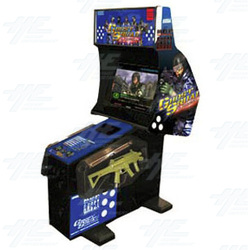

The disadvantage: if you held the diode in a different, white light, a hit was automatically achieved.Ī conventional light gun can not function correctly on plasma and LCD screens as well as with rear projection televisions and video projectors. If the photodiode received this white light, a hit was registered. In the original method, when the trigger was pulled, a black image was generated that contained white squares instead of the targets. The player does not notice any of this because the process takes place in a very short time. This is based on the fact that with a cathode ray tube, as it was built into most televisions and monitors at the time, the image is built up line by line one after the other and therefore the pixels are not white at exactly the same time. The computer can now determine where the weapon is aiming by the diode then recognizing white light when the weapon is aimed at the now white target area. Then the target spot turns white on the screen. There are two common versions of this technique, but the basic concept is the same as with the light pen : when the trigger is pulled, the screen goes black and the diode switches to receive. This uses the light signals for aiming, in connection with a well-coordinated electronic mechanism between trigger and graphic programming. The name suggests that the weapon itself shoots a beam of light, but in reality it receives light from the screen through a photodiode in the pistol barrel. The "Lightgun" bears its name because it uses the light to register which point on the screen the player is aiming at. Īn early popular lightgun game: Duck Hunt

Lightguns exist for many platforms, for example for the Nintendo Entertainment System ( Zapper Gun ), for the Sony PlayStation, the Sega Master System, the Sega Saturn, the Sega Dreamcast, the Magnavox Odyssey or the Microsoft Xbox. In addition, there are often concerns on the part of consumers with the fear that the small TV at home is not as suitable for light guns as the large screens of slot machines. This is possibly due to the fact that only a few players are willing to purchase an additional control unit for their system. On the other hand, they are rarely used on the home console market there are only a few compatible games for game consoles. Lightguns are common in arcade games in amusement arcades. Models with force feedback support can also simulate the recoil of the weapon when firing. Lightguns are based on ballistic weapons (mostly pistols ) and are used to target objects on a screen.


 0 kommentar(er)
0 kommentar(er)
